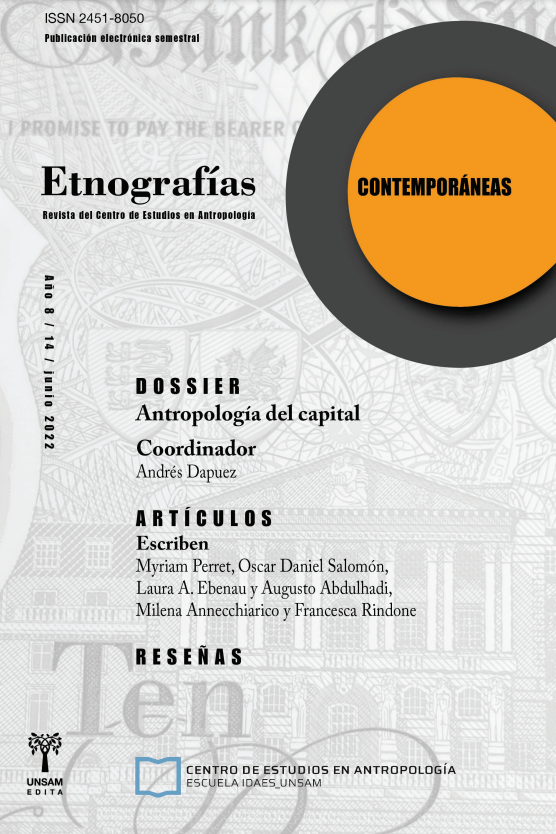Fondos y Activos
Antropología de la riqueza y la economía de la asignación de recursos dentro de la unidad doméstica
Palabras clave:
capital, economía, unidad doméstica, activos, reproducción socialResumen
Los activos están deviniendo en un componente importante de los modelos intra-unidades domésticas. Una perspectiva dinámica de la inversión parece estar inserta en una rama de la economía que todavía usa el modelo unitario de la unidad doméstica. Ninguna perspectiva se ha aproximado sustantiva e históricamente a los activos –a su creación, mantenimiento, y transformaciones polivalentes. Ambas, economía y antropología, no obstante, parecen tratar del mismo conjunto de fenómenos. El estudio de los activos de pequeña escala necesariamente implica un análisis social, cultural y de políticas en un contexto dinámico. Este se construye en el estudio de la diferenciación y el control dentro y más allá de las unidades domésticas y de las familias. Se abre, así, el análisis de la unidad doméstica en Economía un poco más ampliamente que en otras ramas de la antropología, ramas que sin embargo informan profundamente algunos de los análisis de género y parentesco en los cuales los economistas de la unidad doméstica están más familiarizados. Y posiblemente la antropología del valor se abrirá un poco más a la Economía y a la Historia Económica de los activos y de las inversiones para componer el repertorio de opciones en la –ahora muy substancialmente compartidatradición capitalista de formulación de políticas.
Citas
Alderman, H. and Paxson C.H. (1992). Do the poor insure? A synthesis of the literatures on risk and consumption in developing countries. Policy research Working Paper 1008. Washington D.C.: World Bank.
Appadurai, A., ed. (1986). The social life of things: Commodities in cultural perspective. Cambridge, Cambridge University Press.
Bates, R.H. (1990). “Capital, kinship, and conflict: The structuring influence of capital in kingship societies”. Canadian Journal of African Studies 24(2), pp. 151-164.
Becker, G. (1965). “A theory of the allocation of time”. Economic Journal 75, pp. 493-517.
Becker, G. (1981). A treatise on the family. Cambridge, Mass., U.S.A., Harvard University Press.
Berry, S.S. (1989). Social institutions and access to resources. Africa 59 (1). pp. 41-55.
Besley, T. (1993). Savings, credit, and insurance. Discussion Paper 167. Princeton, N.J., U.S.A.:, Woodrow Wilson School of Public and International Affairs, Princeton University.
Brenner, R. (1985). The Brenner debate. Agrarian class structures and economic development in pre-industrial Europe. Cambridge, Cambridge University Press.
Chayanov, A. (1986). A.V. Chayanov and the theory of the peasant economy. Madison, Wis., U.S.A., University of Wisconsin Press.
Cohen, A. (1969). Custom and politics in urban Africa. A study of Hausa migrants in Yoruba towns. Berkeley, Calif. U.S.A., University of California Press.
Daunton, M. J. (1990). Housing. In The Cambridge social history of Britain, 1750-1950, vol.2, ed. F.M. I. Thompson. Cambridge, Cambridge University Press.
Ferguson, J. (1988). “Cultural Exchange: New developments in the anthropology of commodities”. Cultural Anthropology 3(4), pp. 488-513.
–––(1992). “The cultural topography of wealth: Commodity paths and the structure of property in rural Lesotho”. American Anthropologist 94. pp. 55-73.
Goody, J. (1982). Cooking, cuisine, and class: A study of comparative sociology. Cambridge, Cambridge University Press.
Guyer, J. (1993). Wealth in people and self-realization in equatorial Africa. Boston University, Department of Anthropology, Boston. Mimeo.
Guyer, J. I. and P. Peters. (1987). Introduction. Special issue on Conceptualizing the household: Issues on theory and policy in Africa. Development and Change 18(2), pp. 197-213.
Haddad, L., and R. Kanbur (1990). “How serious is the neglect of Intrahousehold inequality?” Economic Journal 100 (402), pp. 866-881.
Hart, K. (1982). “On commoditization.” In From craft to industry: the ethnography of proto-industrial cloth production, ed. E. Goody. Cambridge, Cambridge University Press.
Hill, P. (1972). Rural Hausa. A village and a setting. Cambridge, Cambridge University press.
Humphrey, C. and S. Hugh-Jones (1992). Barter, exchange, and value: An anthropological approach. Cambridge: Cambridge University press.
Levi-Strauss, C. (1949). Les Structures Élémentaires de la Parente. Paris, Mouton.
–––(1969). The raw and the cooked. New York, Harper and Row.
Lewis, O. (1959). Five families: Mexican case studies in the culture of poverty. New York, Basic Books.
Lundberg, S. and and R.A. Pollak (1993). “Separate spheres bargaining and the marriage market.” Journal of Political Economy. 101 (6), pp. 988-1010.
Malinowski, B. (1922). Argonauts of the Western Pacific. London, Routledge.
Mauss, M. (1925). The gift: Forms and functions of exchange in archaic societies. New York:,Norton (1969 Translation).
McElroy, M.B. (1990). “The empirical content of Nash bargained household behavior.” Journal of Human Resources 25 (4) pp. 559-583.
Pitt, M. and V. Lavy. (1992). The Intrahousehold allocation of medical care in Ghana. Paper presented at the iFPRI/World Bank Conference on Intrahousehold Resource Allocation: Policy Issues and research Methods, 12-14 February, Washington, D.C.
Richards, A. I. (1956). Chisingu. A girls’ initiation ceremony among the Bemba of Northern Rhodesia. Londo, Faber and Faber.
Rutz H. J. and B. S. Orlove (1989). The social economy of consumption. Monographs in economic anthropology, No. 6. New York, University Press of America.
Schultz, T. P. (1990). “Testing the neoclassical model of family labor supply and fertility”. Journal of Human Resources 25 (4), pp 599-634.
Sen, A. (1985b). Commodities and capabilities. Amsterdam, Elsevier.
Strathern, M. (1988. The gender of the gift: Problems with women and problems with society in Melanesia. Berkeley, Calif., U.S.A., University of California Press.
Thirsk, J. (1978). Economic policy and projects: The development of consumer society in early modern England. Oxford, Clarendon.
Thomas, D. (1991). Gender differences in household resource allocation. Living Standards Measurement Survey Working Paper 79. Washington, D.C.: World Bank.
–––(1997). Incomes, expenditures, and health Outcomes: Evidences of Intrahousehold Resource Allocation. En: L. Haddad, J. Hoddinott and H. Alderman, eds. Intrahousehold Resource Allocation in Developing Countries. Models, Methods, and Policy. Baltimore, INFRI/Johns Hopkins University Press.
Thomas, N. (1991). Entangled objects. Exchange, material culture, and colonialism in the Pacific. Cambridge, Mass., U.S.A., Harvard University Press.
Weiner, A. B. (1992). Inalienable possessions: The paradox of keeping-while-giving Berkeley, Calif., U.S.A., University of California Press.
Wolf, E. (1969). Peasants wars of the twentieth century. New York, Harper and Row.
























